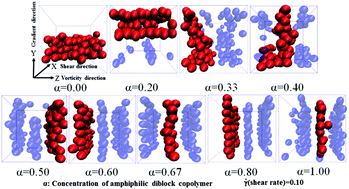Molecular dynamics simulation of the electrical conductive network formation of polymer nanocomposites by utilizing diblock copolymer-mediated nanoparticles†
Abstract
It is very important to improve the electrical conductivities of polymer nanocomposites (PNCs) as this can widen their application. In this work, by employing a coarse-grained molecular dynamics simulation, we investigated the effect of the amphiphilic diblock copolymer (BCP)-mediated nanoparticle (NP) on the conductive probability of polymer nanocomposites (PNCs) in the quiescent state and under a shear field. The conductive probability of PNCs first increases and then decreases with increasing content of BCPs while, interestingly, it exhibits an N-type dependence on the A-Block–NP interaction. Furthermore, the conductive probability shows a non-monotonic dependence on the fraction of A block (fA) in the BCPs, which reaches the maximum value at moderate fA. Under the shear field, NPs self-assemble to form the sandwich-like structures in the matrix above a critical concentration of BCPs, which leads to the anisotropic conductive probability of PNCs. In addition, the sandwich-like structures of NPs will be broken down at a high shear rate, which reduces the difference of the directional conductive probabilities. Last, the mechanism of the formation of the sandwich-like structures of NPs is discussed. In summary, this work presents a simple method to control the conductive network formation, which can help to design PNCs with high electrical conductivity, and especially anisotropy.



 Please wait while we load your content...
Please wait while we load your content...